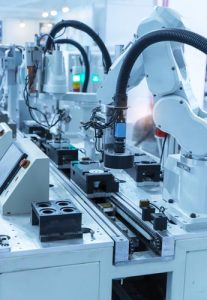The factory of the future calls for technology that is fit for Industry 4.0. Industrial automation and productivity is underpinned by technology across a number of sectors, including machine vision.
Industry 4.0 or the fourth industrial revolution, is the current trend of automation and data exchange in manufacturing technologies. It includes cyber-physical systems, the Internet of things and cloud computing.
Industry 4.0 creates what has been called a “smart factory”. Within the modular structured smart factories, cyber-physical systems monitor physical processes, create a virtual copy of the physical world and make decentralized decisions. Over the Internet of Things, cyber-physical systems communicate and cooperate with each other and with humans in real time, and via the Internet of Services, both internal and cross-organizational services are offered and used by participants of the value chain.
As the Industry 4.0 era takes hold, it’s important to understand the technologies that underpin industrial automation and productivity and also, how they help people work in harmony with the machines. Large-scale production requires highly scalable assembly processes and detailed quality inspection. Fully automated robotics systems put parts together, guide them through the factory, and assure that quality standards are met.
By incorporating sophisticated text recognition Optical Character Recognition (OCR) technologies, machine vision systems can gain ‘reading’ capabilities. Text-based information printed on labels, displayed on control panels or visible on computer screens can be captured, interpreted and processed. While information on paper-based documents such as service reports or product documentation can be converted as part of a scanning process, automation systems capture this information with cameras that have been implemented directly in the production line or testing facility. In both scenarios, the information is available as ‘image-only’ information. OCR technology is then needed to convert this and make it machine readable, searchable and usable.
At UKA, we fully understand the dynamics of having your facility running as a ‘smart factory’. Our engineers will design your lens to meet the precise specifications of each individual reader. We design and manufacture all our precision lenses in house to ensure the highest quality in the industry.
What can a machine actually read? Like humans, the systems can ‘read’ information and subsequently react. Such information includes text and barcodes on packaging as well as images of text on electronic displays. With integrated data capture technologies, robotics, computer vision and quality control systems can process the extracted data and compare it with entries in the database to initiate the system to take the appropriate action. Converted information can be exported to applications and systems in the form of XML data and plain text. With these new capabilities, the robotics systems can conduct a range of completely new tasks.
The benefits of teaching a machine to read and react for themselves across industries where quality and accuracy are key, will ultimately save time, money and help achieve customer satisfaction. All seen through the eyes of a robot.
Universe Kogaku designs and manufactures optical lenses for Robotic Reading Systems, security, high tech and electronic applications. We stock 1000’s of standard lens assemblies and can custom design a solution for scanners, CCTV, CCD/CMOS, medical imaging, surveillance systems, machine vision and night vision systems.